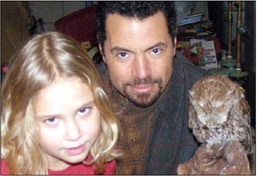Owl-centric experience highlights need for habitat health
Like fingers on a chalk board, a screeching metallic scratching noise within my oil furnace stove pipe at 2:30 in the morning sent shivers through my body.
What could be making that noise?
It moved down the piping toward the damper — the door opened ever so slightly, and an inch-long, razor-sharp talon popped out.
I sprung to action, grabbing a nearby fireplace poker and using that to hold the damper door closed while my mind raced on what could belong to a talon that big, sharp and intimidating?
It was too menacing to be a squirrel, too small to be a bobcat.
Like any responsible
homeowner who can’t afford an emergency pest control service, I decided to secure the damper door with tape and other items laying around until the lessexpensive pest control options were available during business hours.
I learned in the morning that even those options don’t fit into a journalist’s budget, so my wife and I decided to handle the monster in our stove pipe on our own.
Armed with a flashlight, Leatherman, canvas leaf-blower bag, duct tape and my fireplace poker, we started removing pieces of pipe to reveal the beast within.
A 5.1-ounce screech owl.
My plans for a violent attack on the intruder dissolved quickly. This owl was so tiny, obviously lost and terrified. I couldn’t bring myself to poke her with the poker.
So I called Snyder County falconer Mike Dupuy, who rescued her from our chimney flue while giving my then-6-year-old daughter a lesson in wildlife recovery.
Screech owls are cavity dwellers — meaning they search for small open places to roost and nest. Typically that is a hollowed-out tree, but for one night, that happened to by my rural Middleburg chimney.
In the nine years since that incident, Dupuy has learned quite a bit more about screech owls. He kept the rescued bird on his property after she recovered, starting a program of nesting pairs he has studied carefully via nesting box cameras.
‘These guys are fierce little killers — every night they come home with
food,” he said. “I expected there to be a lot of mice and voles, but have been surprised at the number of smaller birds they bring back — I’d say 40-50 percent of their kills have been birds.”
He has also seen a trend of birds that will peek into the nesting box hole during the day when the screech owls are not active, as if to say, Dupuy added: “I know you killed my cousin Vinny — I’m keeping an eye on you.”
Dupuy’s research has helped highlight another trend — something with bigger ramifications on not just the screech owl population, but also the full local ecosystem.
‘Habitat continues to decline. People will cut down dead trees for firewood or because they feel it is a danger or an eyesore,” he said. ‘However, as we eliminate all this potential habitat, it reduces the places screech owls and other cavity-dwellers (like the kestrel) can live.”
That leads these little owls to search for new places to stay — like a dormant chimney where they can terrify homeowners in the middle of the night.
Dupuy’s solution comes in the form of nesting boxes that can be obtained at his residence and placed in woodlots (for screech owls) or overlooking open fields (for kestrels).
“We all have a part to play in helping our nature-based neighbors, and this is just one way to make a difference,” he said.

